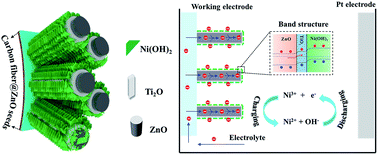Band alignment engineering for high-energy-density solid-state asymmetric supercapacitors with TiO2 insertion at the ZnO/Ni(OH)2 interface†
Abstract
In this paper, an adaptive interface electronic band structure was proposed for improving the capacitance of nano-architectured Ni(OH)2 by introducing a TiO2 embedding layer at the ZnO/Ni(OH)2 interface. A stair-like band alignment was designed to reduce the electron interface transport barrier and induce efficient electron-injection through the interface to the reaction region when it is charging. Consequently, the activation energy of reduction dropped, which further brought about a decreased equilibrium potential (Eeq) depending on the Butler–Volmer model of electrode kinetics. As expected, a superior capacitance of 1981 F g−1 at 2 A g−1 was triggered. After that, this advanced electrode was assembled in an asymmetric cell with a ZnO@Fe2O3 based negative electrode; the as-fabricated device delivered a high energy density of 52.2 W h kg−1 at a power density of 1.3 kW kg−1 within the voltage range of 0–1.6 V as well as a good cycling performance (96.6% capacity retention after 5000 cycles). These features demonstrate that suitable interface engineering may open up new opportunities in the development of high-performance supercapacitors.


 Please wait while we load your content...
Please wait while we load your content...